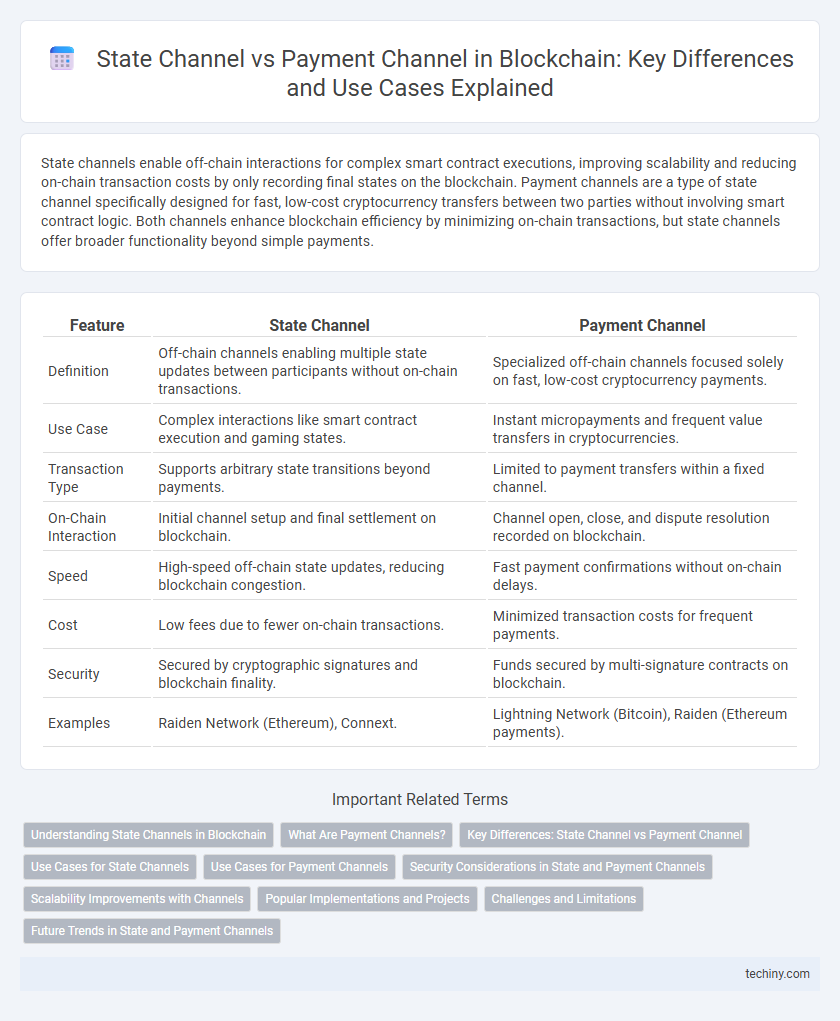State channels enable off-chain interactions for complex smart contract executions, improving scalability and reducing on-chain transaction costs by only recording final states on the blockchain. Payment channels are a type of state channel specifically designed for fast, low-cost cryptocurrency transfers between two parties without involving smart contract logic. Both channels enhance blockchain efficiency by minimizing on-chain transactions, but state channels offer broader functionality beyond simple payments.
Table of Comparison
| Feature | State Channel | Payment Channel |
|---|---|---|
| Definition | Off-chain channels enabling multiple state updates between participants without on-chain transactions. | Specialized off-chain channels focused solely on fast, low-cost cryptocurrency payments. |
| Use Case | Complex interactions like smart contract execution and gaming states. | Instant micropayments and frequent value transfers in cryptocurrencies. |
| Transaction Type | Supports arbitrary state transitions beyond payments. | Limited to payment transfers within a fixed channel. |
| On-Chain Interaction | Initial channel setup and final settlement on blockchain. | Channel open, close, and dispute resolution recorded on blockchain. |
| Speed | High-speed off-chain state updates, reducing blockchain congestion. | Fast payment confirmations without on-chain delays. |
| Cost | Low fees due to fewer on-chain transactions. | Minimized transaction costs for frequent payments. |
| Security | Secured by cryptographic signatures and blockchain finality. | Funds secured by multi-signature contracts on blockchain. |
| Examples | Raiden Network (Ethereum), Connext. | Lightning Network (Bitcoin), Raiden (Ethereum payments). |
Understanding State Channels in Blockchain
State channels in blockchain enable off-chain transactions that allow multiple parties to execute smart contract interactions privately and instantly, significantly reducing on-chain congestion and transaction fees. Unlike payment channels, which are primarily designed for fast, off-chain cryptocurrency transfers between two parties, state channels support complex state updates beyond simple payments, encompassing any arbitrary contract logic. This scalability solution improves blockchain throughput by minimizing the number of transactions recorded on-chain while maintaining security through cryptographic proofs.
What Are Payment Channels?
Payment channels are a type of state channel specifically designed to facilitate multiple off-chain transactions between parties, enabling faster and cheaper payments without requiring each transaction to be recorded on the blockchain. These channels lock a certain amount of cryptocurrency in a multi-signature address, allowing participants to transact repeatedly by exchanging signed, off-chain messages that update balances. This method reduces on-chain transaction fees and enhances scalability for micropayments and frequent transfers in decentralized applications.
Key Differences: State Channel vs Payment Channel
State channels enable off-chain execution of arbitrary smart contract interactions, allowing multiple complex transactions without recording each on the blockchain, whereas payment channels are specialized state channels focused solely on conducting off-chain token transfers between participants. State channels support a broad range of decentralized applications by updating any state changes off-chain, while payment channels streamline high-frequency micropayments to reduce fees and latency. The fundamental difference lies in scope: state channels handle comprehensive state changes across dApps, whereas payment channels specifically optimize the transfer of digital assets.
Use Cases for State Channels
State channels enable secure off-chain transactions for complex interactions such as gaming, decentralized exchanges, and microservices, reducing on-chain congestion and costs. Unlike payment channels which mainly facilitate rapid cryptocurrency transfers, state channels support a broader range of state changes including smart contract executions and multi-party agreements. Use cases for state channels include blockchain-based gaming with instant move verification, decentralized finance protocols requiring multiple transaction states, and scalable auctions or governance voting systems.
Use Cases for Payment Channels
Payment channels enable rapid, low-cost microtransactions ideal for use cases such as streaming services, online gaming, and IoT device payments. They facilitate off-chain transactions between two parties while maintaining security and trust through blockchain settlements. This makes payment channels a preferred choice for high-frequency, small-value transfers where minimizing on-chain fees and latency is critical.
Security Considerations in State and Payment Channels
State channels offer enhanced security by enabling off-chain transactions that reduce exposure to on-chain attack vectors, while ensuring final state settlement on the blockchain for irreversible consensus. Payment channels, designed primarily for fast, low-cost value transfer, rely on cryptographic guarantees and time-locked contracts to prevent double-spending and fraud during bidirectional fund exchanges. Both channels incorporate security measures such as dispute resolution mechanisms and multi-signature schemes to safeguard user funds and maintain transaction integrity.
Scalability Improvements with Channels
State channels and payment channels both enhance blockchain scalability by enabling off-chain transactions that reduce on-chain congestion. Payment channels primarily handle simple fund transfers between parties, optimizing microtransactions with low latency and minimal fees. State channels extend this concept to complex interactions, supporting broader smart contract executions off-chain, which significantly decreases on-chain computational load and increases throughput.
Popular Implementations and Projects
State channels are widely implemented in projects like Connext and Counterfactual, enabling off-chain smart contract execution for various decentralized applications beyond just payments. Payment channels, primarily used in the Bitcoin Lightning Network and Ethereum's Raiden Network, focus on facilitating fast, low-cost microtransactions between parties. Both technologies optimize blockchain scalability, but state channels offer broader functionality with popular adoption in multi-use platforms, while payment channels remain the go-to solution for instant cryptocurrency transfers.
Challenges and Limitations
State channels face scalability challenges due to complex off-chain state management and the need for frequent dispute resolution on-chain, causing latency and higher costs. Payment channels offer faster transaction speeds but are limited to simple monetary transfers, restricting their applicability for complex smart contract interactions. Both channels require robust security measures to prevent fraud and ensure finality, while liquidity constraints can hinder seamless user experience in large networks.
Future Trends in State and Payment Channels
State channels are evolving to support complex off-chain smart contracts, enabling faster and more scalable blockchain interactions beyond simple payments. Payment channels remain pivotal for microtransactions and instant fund transfers, with future trends emphasizing interoperability and reduced transaction costs. Integration of state and payment channels with Layer 2 solutions will drive mass adoption and enhance blockchain efficiency.
State Channel vs Payment Channel Infographic

 techiny.com
techiny.com